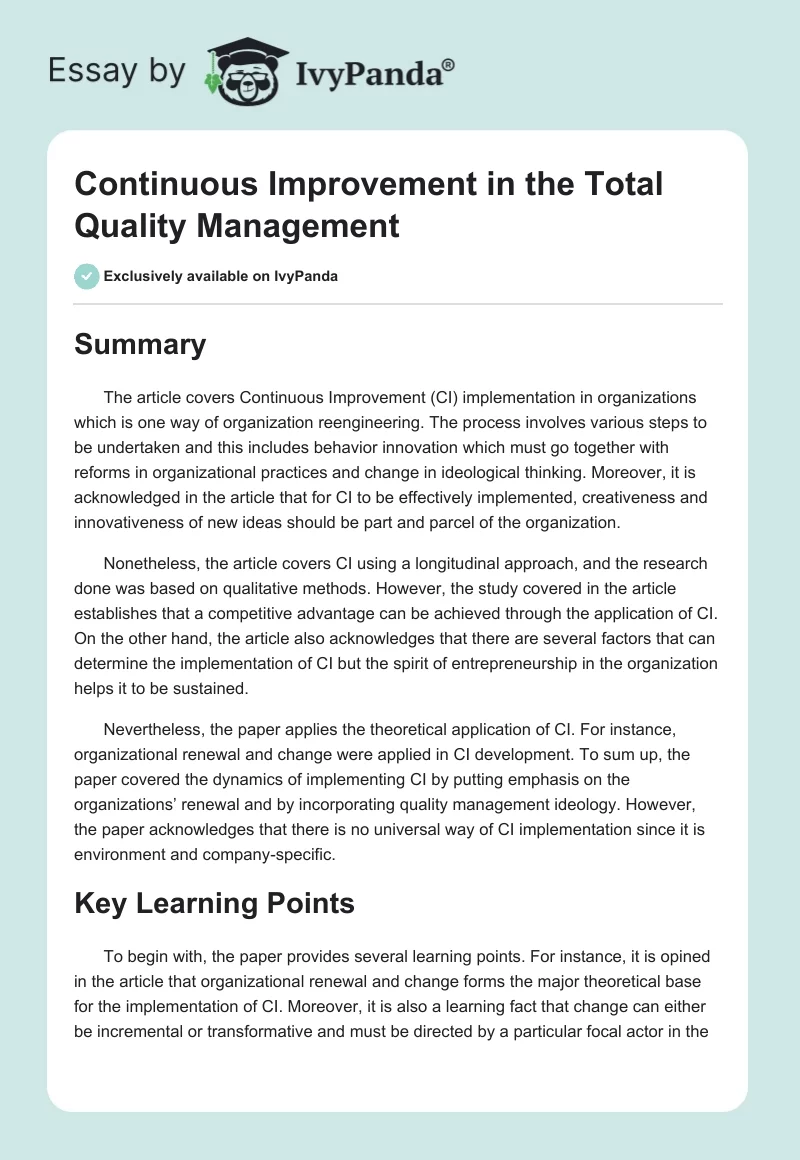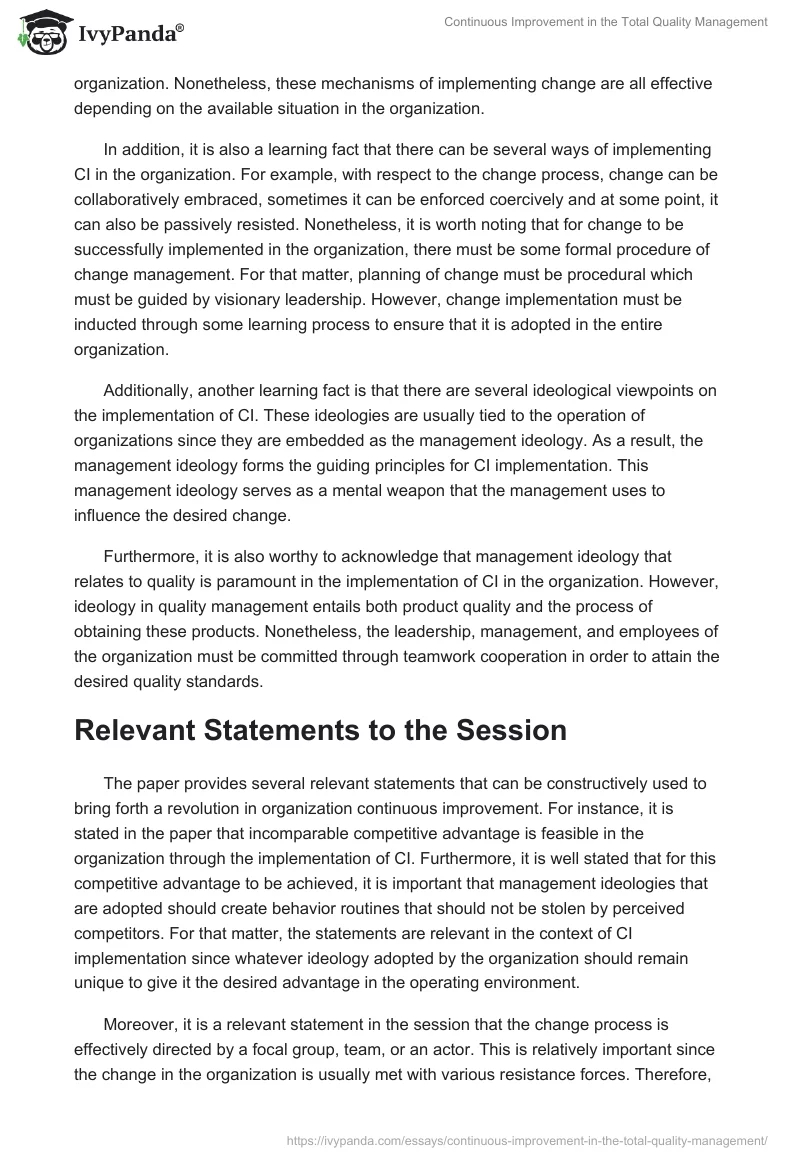Summary
The article covers Continuous Improvement (CI) implementation in organizations which is one way of organization reengineering. The process involves various steps to be undertaken and this includes behavior innovation which must go together with reforms in organizational practices and change in ideological thinking. Moreover, it is acknowledged in the article that for CI to be effectively implemented, creativeness and innovativeness of new ideas should be part and parcel of the organization.
Nonetheless, the article covers CI using a longitudinal approach, and the research done was based on qualitative methods. However, the study covered in the article establishes that a competitive advantage can be achieved through the application of CI. On the other hand, the article also acknowledges that there are several factors that can determine the implementation of CI but the spirit of entrepreneurship in the organization helps it to be sustained.
Nevertheless, the paper applies the theoretical application of CI. For instance, organizational renewal and change were applied in CI development. To sum up, the paper covered the dynamics of implementing CI by putting emphasis on the organizations’ renewal and by incorporating quality management ideology. However, the paper acknowledges that there is no universal way of CI implementation since it is environment and company-specific.
Key Learning Points
To begin with, the paper provides several learning points. For instance, it is opined in the article that organizational renewal and change forms the major theoretical base for the implementation of CI. Moreover, it is also a learning fact that change can either be incremental or transformative and must be directed by a particular focal actor in the organization. Nonetheless, these mechanisms of implementing change are all effective depending on the available situation in the organization.
In addition, it is also a learning fact that there can be several ways of implementing CI in the organization. For example, with respect to the change process, change can be collaboratively embraced, sometimes it can be enforced coercively and at some point, it can also be passively resisted. Nonetheless, it is worth noting that for change to be successfully implemented in the organization, there must be some formal procedure of change management. For that matter, planning of change must be procedural which must be guided by visionary leadership. However, change implementation must be inducted through some learning process to ensure that it is adopted in the entire organization.
Additionally, another learning fact is that there are several ideological viewpoints on the implementation of CI. These ideologies are usually tied to the operation of organizations since they are embedded as the management ideology. As a result, the management ideology forms the guiding principles for CI implementation. This management ideology serves as a mental weapon that the management uses to influence the desired change.
Furthermore, it is also worthy to acknowledge that management ideology that relates to quality is paramount in the implementation of CI in the organization. However, ideology in quality management entails both product quality and the process of obtaining these products. Nonetheless, the leadership, management, and employees of the organization must be committed through teamwork cooperation in order to attain the desired quality standards.
Relevant Statements to the Session
The paper provides several relevant statements that can be constructively used to bring forth a revolution in organization continuous improvement. For instance, it is stated in the paper that incomparable competitive advantage is feasible in the organization through the implementation of CI. Furthermore, it is well stated that for this competitive advantage to be achieved, it is important that management ideologies that are adopted should create behavior routines that should not be stolen by perceived competitors. For that matter, the statements are relevant in the context of CI implementation since whatever ideology adopted by the organization should remain unique to give it the desired advantage in the operating environment.
Moreover, it is a relevant statement in the session that the change process is effectively directed by a focal group, team, or an actor. This is relatively important since the change in the organization is usually met with various resistance forces. Therefore, a focal leader must be in place to ensure that the desired CI is implemented by ensuring that change is made possible. In addition, the focal leader also acts as an inspirational pillar in the implementation process.
Furthermore, it is relevantly stated that there is no single way of implementing change in the process of continuous improvement. This is so since appropriate strategies for change implementation depends on the organization’s stage of development. For that matter, it is important to put in mind that no predefined strategies of change management are available for CI but the strategies must be crafted that should be inclined to the organization’s operating environment and its unique features.
Critical Analysis
It can be critically analyzed that strategies in continuous improvement are dynamic rather than static as earlier perceived. For instance, from the case study, it is provided that initially strategies were seller dominated in the early 1980s but it is now clients’ centered. As a result, new strategies are being outsourced and now quality issues have become the guiding principles in product production. Therefore, it can be critically opined that continuous improvement in the organization can emanate from within or from without. However, the top management in the organization must play a central role in ensuring the implementation of continuous improvement. For instance, they need to be motivational pillars towards the attainment of the set qualities.
Moreover, it can be critically analyzed that after a successful long period of continuous improvement, a positive culture to support and sustain quality standards is usually achieved. For instance, after ten years of sustained improvement, the Construction Company developed a cultural pattern that guided its business operations which resulted in long term quality standards in its products.
Furthermore, it is a well-known fact that continuous improvement in the organization is heavily determined by environmental factors. For example, the quality implementation may be necessitated by financial conditions of the environment since the improvement in the national economy facilitates continuous improvement while recessions in national economies are backward drivers of continuous improvement.
Additionally, it is prudent to embrace management ideologies in organizations that are geared towards supporting continuous improvement. These help since they act as inspirational factors in the implementation process. Nonetheless, these management ideologies must be in line with the broader organizational strategic plans to ensure that there is conformity in operations.
Practical Implications
Implementation of continuous improvement in the organization brings forth the desired revolution by achieving the set goals. However, for the set goals to be achieved in a real business case, several things need to be instituted. First and foremost, it is important to have long-term strategic plans that span for a long period of time. For instance, the plans might for a ten or twenty-year period. Moreover, in the set plans, short and long term goals must be well stipulated in order to act standards to which results should be measured against.
Thereafter, implementation strategies must be crafted to provide a defined layout of how the implementation process will be done. Since continuous improvement is an organization-wide activity, every level of management in the organization must be assigned specific implementation tasks and activities in order to make every stakeholder accountable and responsible in the entire implementation process.
In addition, the organization’s leadership must come up with an organizational ideology that must serve as a mental weapon for inspirational function. However, the top management must come out as a focal factor in the implementation process. The management must act as a regulator in the process to ensure that the entire process of the CI process stays on course. Lastly, there must be regular reviews of the implementation process.
Learning Reflections
There are several lessons learned from CI. One of the central lessons is that in the CI process, there is no universally accepted strategy to apply but it all depends on the specific company and the environment of operation. Moreover, it also evident that the implementation process follows a nonstraightforward process that is gradual and cyclical.
Furthermore, it is worth noting that various environmental forces also come to the fore in the implementation process of CI. Therefore, it is important to consider these factors in the planning process.
Lastly, it is also a lesson that the implementation exercise of CI is heavily embedded in the management influence. The top management of the organization plays a pertinent role in the implementation process since they serve as inspirational leaders. They are also responsible for crafting management ideologies that serve as mental weapons in the implementation process.


